Abstract
Polyalkylcyanoacrylate (PACA) nanoparticles loaded with doxorubicin allowed multidrug resistance to be overcome in vitro. However, increased cytotoxicity is not always correlated with an increased level of intracellular drug. Although we have previously shown that PACA nanoparticles are not endocytosed by tumour cells, we report here that a direct interaction between nanoparticles and cells is a necessary requirement for overcoming resistance. In addition, the results showed that the degradation products of PACA (mainly polycyanoacrylic acid) in the presence of doxorubicin are able to increase both accumulation and cytotoxicity, thus suggesting the formation of a doxorubicin-polycyanoacrylic acid ion pair. It is therefore concluded that resistance is overcome as a result of both the adsorption of nanoparticles to the cell surface and increased doxorubicin diffusion by the accumulation of an ion pair at the plasma membrane.
Full text
PDF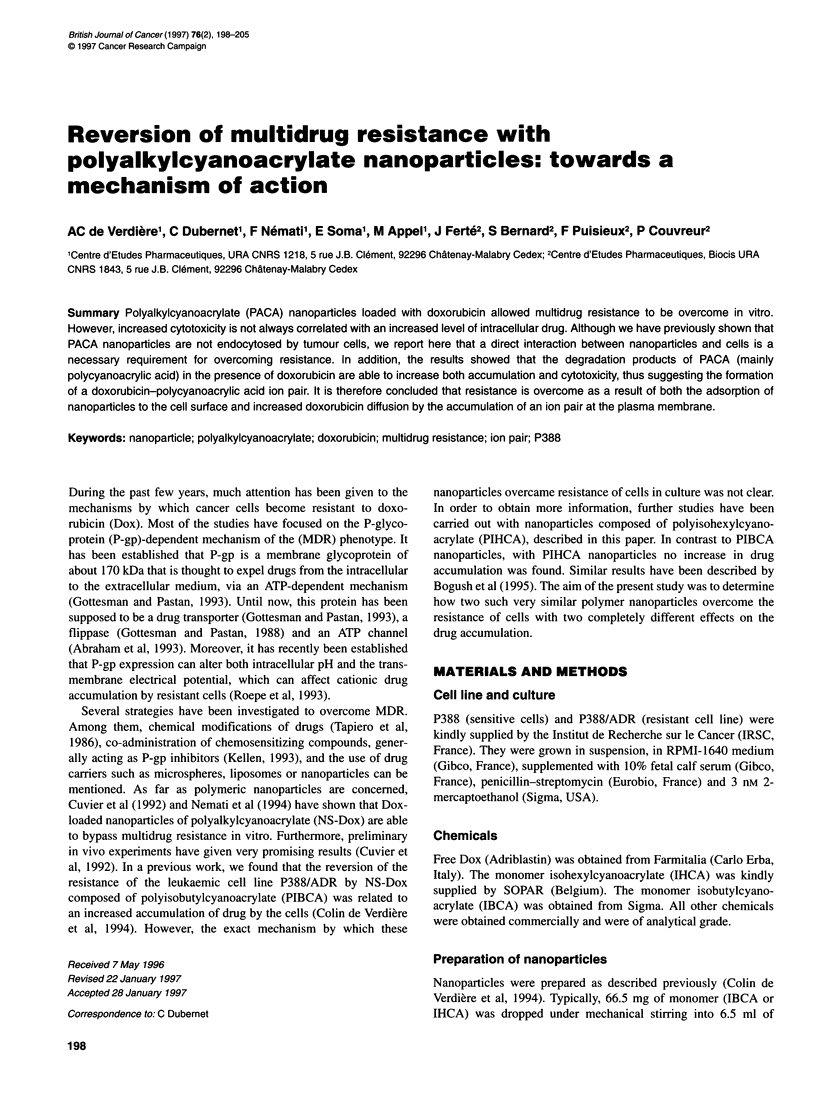
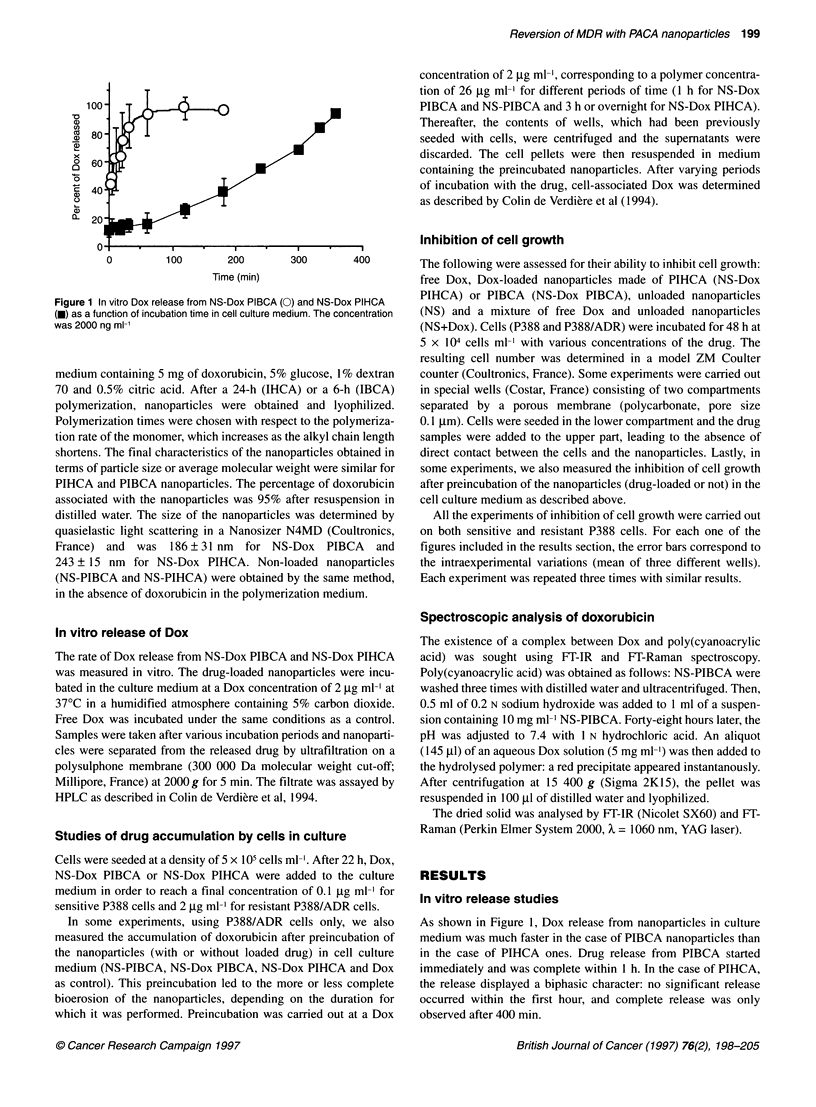
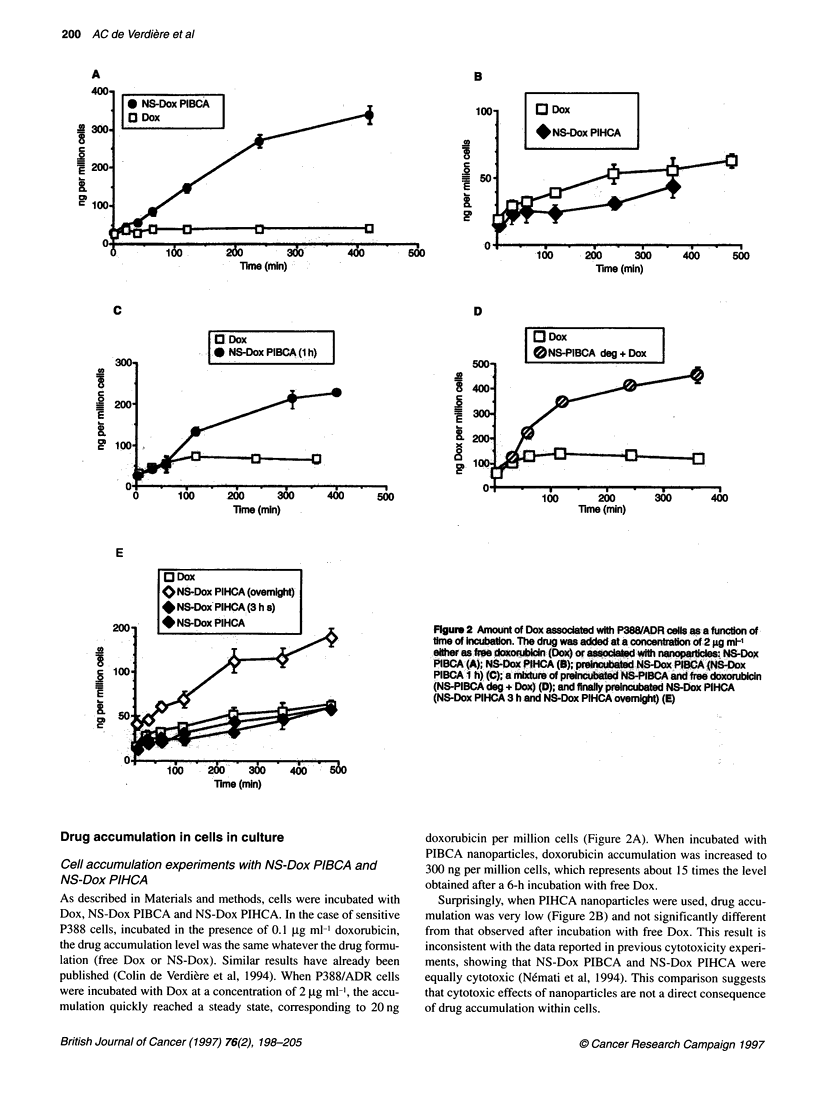
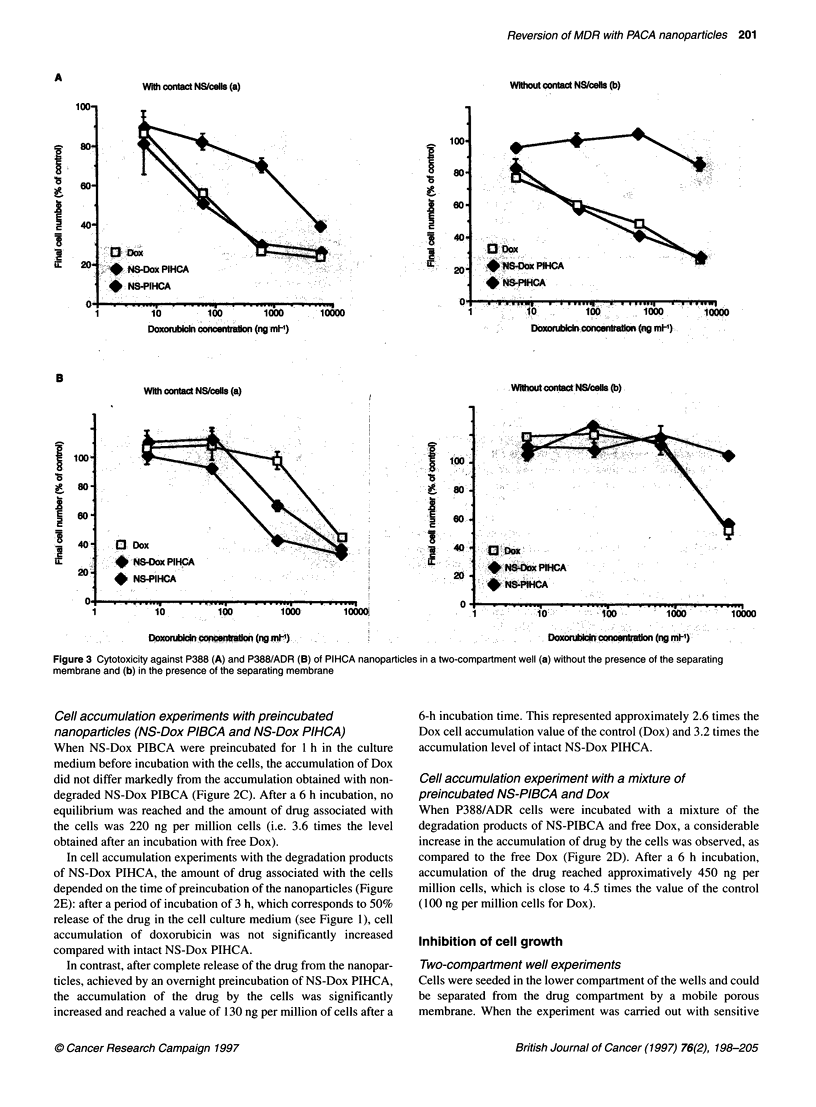
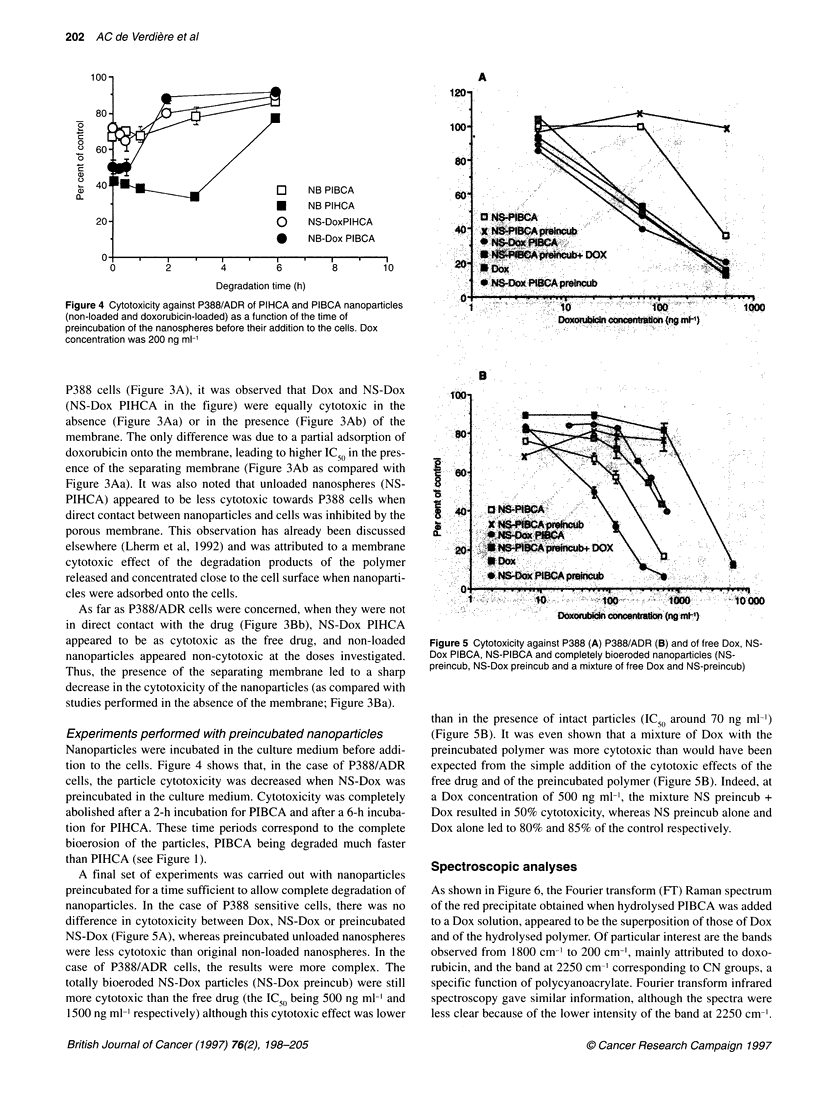
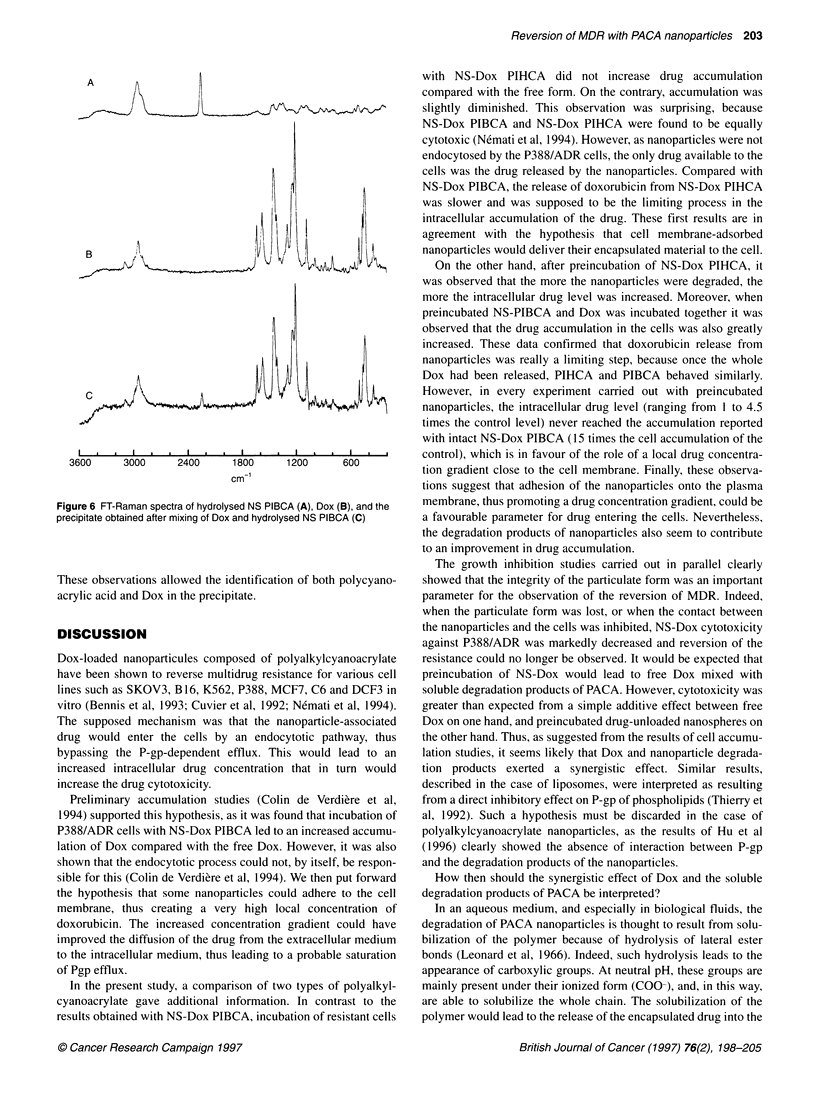
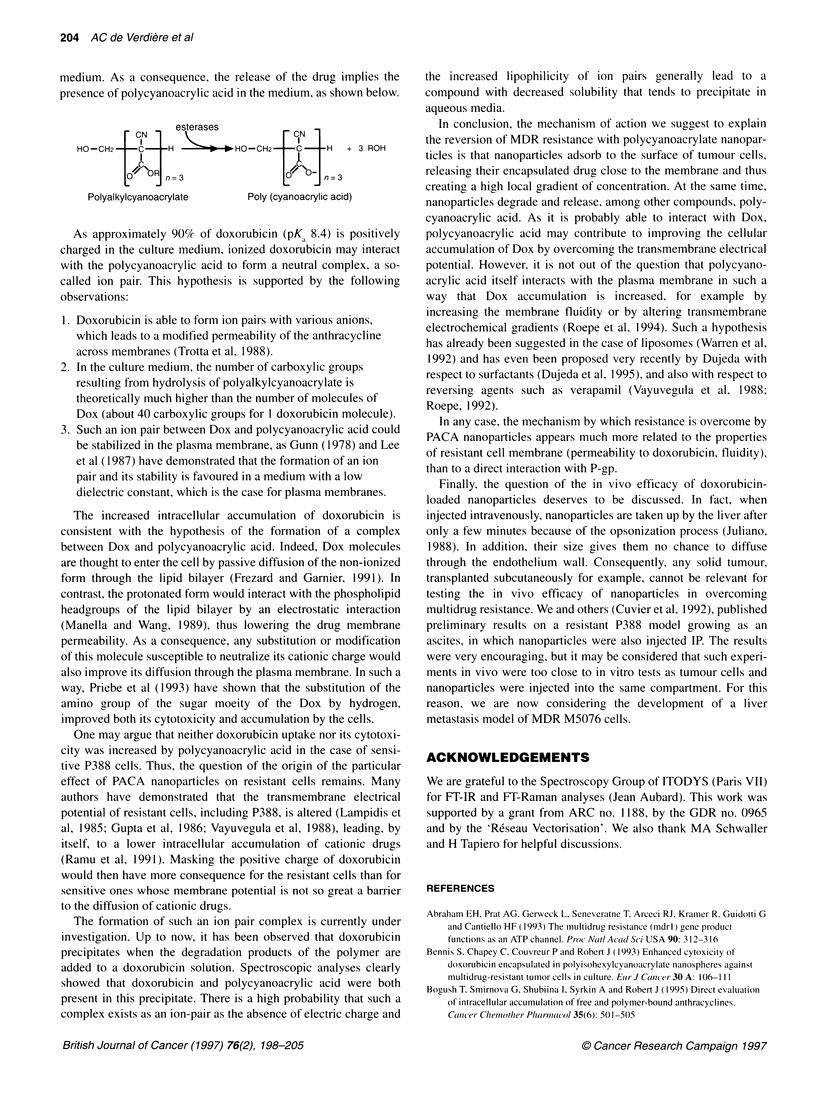
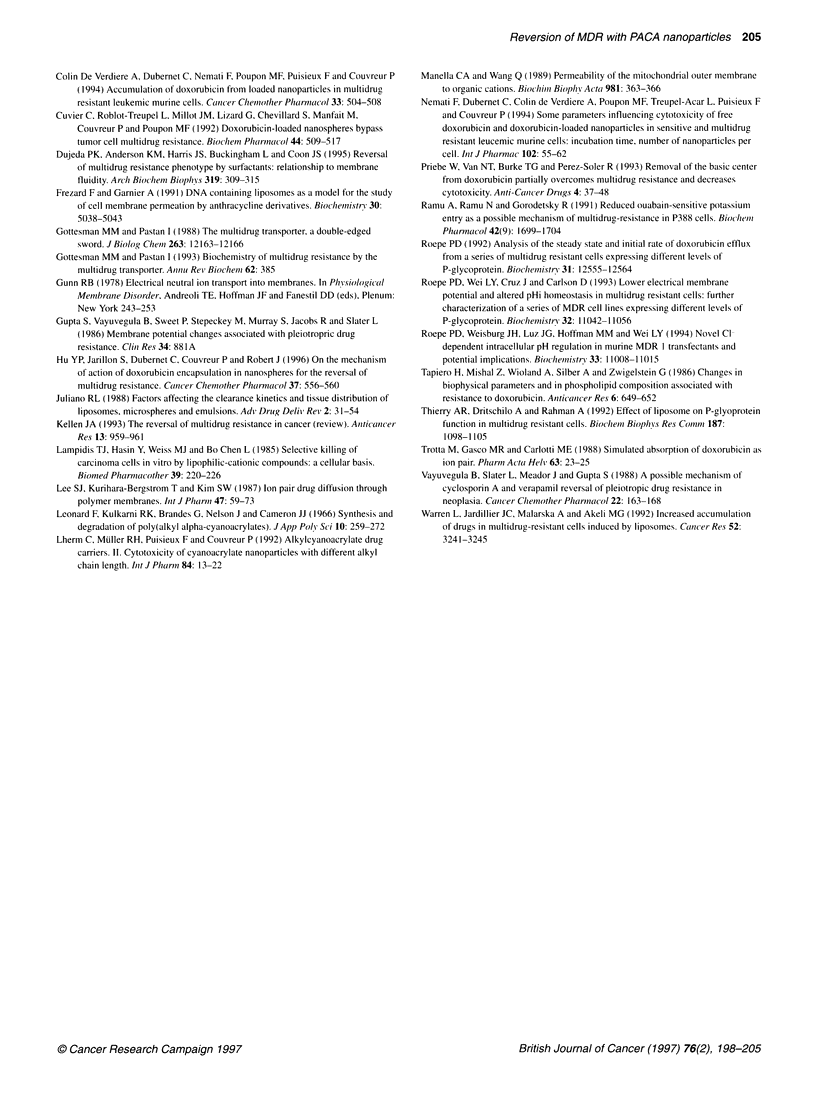
Selected References
These references are in PubMed. This may not be the complete list of references from this article.
- Abraham E. H., Prat A. G., Gerweck L., Seneveratne T., Arceci R. J., Kramer R., Guidotti G., Cantiello H. F. The multidrug resistance (mdr1) gene product functions as an ATP channel. Proc Natl Acad Sci U S A. 1993 Jan 1;90(1):312–316. doi: 10.1073/pnas.90.1.312. [DOI] [PMC free article] [PubMed] [Google Scholar]
- Bogush T., Smirnova G., Shubina I., Syrkin A., Robert J. Direct evaluation of intracellular accumulation of free and polymer-bound anthracyclines. Cancer Chemother Pharmacol. 1995;35(6):501–505. doi: 10.1007/BF00686835. [DOI] [PubMed] [Google Scholar]
- Colin de Verdière A., Dubernet C., Nemati F., Poupon M. F., Puisieux F., Couvreur P. Uptake of doxorubicin from loaded nanoparticles in multidrug-resistant leukemic murine cells. Cancer Chemother Pharmacol. 1994;33(6):504–508. doi: 10.1007/BF00686509. [DOI] [PubMed] [Google Scholar]
- Cuvier C., Roblot-Treupel L., Millot J. M., Lizard G., Chevillard S., Manfait M., Couvreur P., Poupon M. F. Doxorubicin-loaded nanospheres bypass tumor cell multidrug resistance. Biochem Pharmacol. 1992 Aug 4;44(3):509–517. doi: 10.1016/0006-2952(92)90443-m. [DOI] [PubMed] [Google Scholar]
- Dudeja P. K., Anderson K. M., Harris J. S., Buckingham L., Coon J. S. Reversal of multidrug resistance phenotype by surfactants: relationship to membrane lipid fluidity. Arch Biochem Biophys. 1995 May 10;319(1):309–315. doi: 10.1006/abbi.1995.1298. [DOI] [PubMed] [Google Scholar]
- Gottesman M. M., Pastan I. Biochemistry of multidrug resistance mediated by the multidrug transporter. Annu Rev Biochem. 1993;62:385–427. doi: 10.1146/annurev.bi.62.070193.002125. [DOI] [PubMed] [Google Scholar]
- Gottesman M. M., Pastan I. The multidrug transporter, a double-edged sword. J Biol Chem. 1988 Sep 5;263(25):12163–12166. [PubMed] [Google Scholar]
- Hu Y. P., Jarillon S., Dubernet C., Couvreur P., Robert J. On the mechanism of action of doxorubicin encapsulation in nanospheres for the reversal of multidrug resistance. Cancer Chemother Pharmacol. 1996;37(6):556–560. doi: 10.1007/s002800050428. [DOI] [PubMed] [Google Scholar]
- Kellen J. A. The reversal of multidrug resistance in cancer (review). Anticancer Res. 1993 Jul-Aug;13(4):959–961. [PubMed] [Google Scholar]
- Lampidis T. J., Hasin Y., Weiss M. J., Chen L. B. Selective killing of carcinoma cells "in vitro" by lipophilic-cationic compounds: a cellular basis. Biomed Pharmacother. 1985;39(5):220–226. [PubMed] [Google Scholar]
- Mannella C. A., Wang Q. Permeability of the mitochondrial outer membrane to organic cations. Biochim Biophys Acta. 1989 Jun 6;981(2):363–366. doi: 10.1016/0005-2736(89)90049-7. [DOI] [PubMed] [Google Scholar]
- Priebe W., Van N. T., Burke T. G., Perez-Soler R. Removal of the basic center from doxorubicin partially overcomes multidrug resistance and decreases cardiotoxicity. Anticancer Drugs. 1993 Feb;4(1):37–48. doi: 10.1097/00001813-199302000-00005. [DOI] [PubMed] [Google Scholar]
- Ramu A., Ramu N., Gorodetsky R. Reduced ouabain-sensitive potassium entry as a possible mechanism of multidrug-resistance in P388 cells. Biochem Pharmacol. 1991 Oct 9;42(9):1699–1704. doi: 10.1016/0006-2952(91)90504-x. [DOI] [PubMed] [Google Scholar]
- Roepe P. D. Analysis of the steady-state and initial rate of doxorubicin efflux from a series of multidrug-resistant cells expressing different levels of P-glycoprotein. Biochemistry. 1992 Dec 22;31(50):12555–12564. doi: 10.1021/bi00165a003. [DOI] [PubMed] [Google Scholar]
- Roepe P. D., Wei L. Y., Cruz J., Carlson D. Lower electrical membrane potential and altered pHi homeostasis in multidrug-resistant (MDR) cells: further characterization of a series of MDR cell lines expressing different levels of P-glycoprotein. Biochemistry. 1993 Oct 19;32(41):11042–11056. doi: 10.1021/bi00092a014. [DOI] [PubMed] [Google Scholar]
- Roepe P. D., Weisburg J. H., Luz J. G., Hoffman M. M., Wei L. Y. Novel Cl(-)-dependent intracellular pH regulation in murine MDR 1 transfectants and potential implications. Biochemistry. 1994 Sep 13;33(36):11008–11015. doi: 10.1021/bi00202a021. [DOI] [PubMed] [Google Scholar]
- Tapiero H., Mishal Z., Wioland M., Silber A., Fourcade A., Zwingelstein G. Changes in biophysical parameters and in phospholipid composition associated with resistance to doxorubicin. Anticancer Res. 1986 Jul-Aug;6(4):649–652. [PubMed] [Google Scholar]
- Thierry A. R., Dritschilo A., Rahman A. Effect of liposomes on P-glycoprotein function in multidrug resistant cells. Biochem Biophys Res Commun. 1992 Sep 16;187(2):1098–1105. doi: 10.1016/0006-291x(92)91310-m. [DOI] [PubMed] [Google Scholar]
- Trotta M., Gasco M. R., Carlotti M. E. Simulated absorption of doxorubicin as ion pair. Pharm Acta Helv. 1988;63(1):23–25. [PubMed] [Google Scholar]
- Vayuvegula B., Slater L., Meador J., Gupta S. Correction of altered plasma membrane potentials. A possible mechanism of cyclosporin A and verapamil reversal of pleiotropic drug resistance in neoplasia. Cancer Chemother Pharmacol. 1988;22(2):163–168. doi: 10.1007/BF00257315. [DOI] [PubMed] [Google Scholar]
- Warren L., Jardillier J. C., Malarska A., Akeli M. G. Increased accumulation of drugs in multidrug-resistant cells induced by liposomes. Cancer Res. 1992 Jun 1;52(11):3241–3245. [PubMed] [Google Scholar]


